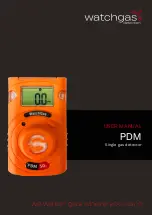
10
E. SwING-AwAy SwITCh (If
AppLICABLE)
The Swing-Away Cutout Switch (Optional) is a pre-
wired switch mounted on the swing-away, bracket.
Its purpose is to prevent the Metal Detector from
tripping when the transmitter coil is hit by an over-
burden of material. Route the free end of this cable
in the same conduit as the trans mitter cable to the
Main Control Enclosure. Refer to the Control Con-
nection Diagram for hook-up.
f. CLIp DETECTOR (If
AppLICABLE)
Install the Clip Detector Unit as follows:
• Refer to Control Connection and Frame Assem
bly Diagrams.
Position the Clip Detector Sensor approximately
(but no closer than) 2' (610 mm) from the center
line of the receiver coil on the upstream side of the
Search Coil Assembly. If there are idlers adjacent
to the search coils, position the Clip Detector Sen-
sor approximately 1” to 3" (25-76 mm) upstream of
the nearest upstream idler before the Search Coil
Assembly. The flat face of the Clip Detector should
be facing toward the belt with approximately 1/2"
-1" (12-25 mm) of clearance. This clearance
must
be maintained in order to assure proper operation.
The Clip Detector should be a few inches (about 50
mm) from the edge of the belt.
Do not mount the
Sensor too far from the edge, as tramp metal Iying
close to the belt may trigger the sensor and pass
through the search coils as a repair splice.
• With the Clip Detector Sensor in the proper
posi tion below the belt, weld the 3/4” support
pipe (provided) to the conveyor name. The pipe
may be cut to the proper size for an easier fit.
The multi-axis swivel joint will provide adequate
move ment for proper adjustment.
• It is recommended that the Clip Detector cable,
running to the Main Control Enclosure be in-
stalled in conduit. The same conduit that houses
the transmitter coil cable may be used.
• Feed the Clip Detector cable into the conduit,
from the Clip Detector end to the Main Control
Enclosure.
• Cut off excess cable. Connect wires to terminal
block (TB1) using the supplied spade lugs. Refer
to the Control Connection Diagram for color code
hook-up. Be certain all wires are attached secure-
ly and connected to their proper terminals.
• Where metal repair clips are used two or more
clips close together must pass directly over the
Clip Detector Sensor in order to activate it. If a
small patch of clips is used on the belt which
would not pass directly over the Clip Detector,
reference clips are required. Reference clips
are made by installing two or more clips which
will pass directly over the Clip Detector to trip it
when a small patch passes by. Numerous repair
and reference clips on the belt will degrade the
Detector’s performance because it will frequently
be in a desensitized mode.
G. MARkING DEvICE (If
AppLICABLE)
The Marking Device is a pressurized solenoid
activated liquid spray system which pinpoints the
location of tramp metal to eliminate costly search
and downtime.
SpECIfICATIONS
Tank Pressure Rating: 150 psig (maximum working
pressure) (10 bar)
Tank Capacity: 3 Gallons (11.1 l) (liquid)
Operational Voltage: 115/220 (50/60 Hz), 15 Watts
Air: Plant air or any source of 100 to 200 psig inert
gas (6.5-13 bar)
INSTALLATION INSTRUCTIONS
• Refer to the Sensing Coil and Frame Assembly
Drawing, for layout of the Marking Device on
the belt.
• Position the solenoid support upright and cross arm
as shown. Distance from the coils should be 3’ to
6' (.9 m to 1.8 m). Clamp in place temporarily
part II - Installation
(cont.)
Summary of Contents for 1250 ANALOG
Page 6: ...6 Part I Operation Description cont FIGURE 1 MAIN CONTROL ENCLOSURE NEMA 4 4X 7 OR 9...
Page 7: ...7 Part I Operation Description cont FIGURE 2 ELECTRONIC MODULE...
Page 11: ...11 Part II Installation cont FIGURE 3 SWING AWAY FRAME ASSEMBLY FIGURE 4 FIXED FRAME ASSEMBLY...
Page 13: ...13 Part II Installation cont...
Page 20: ...20 TABLE 6 PROGRAMMING CONTROLS SUMMARY Part IV System Programming cont...
Page 21: ...21 Part IV System Programming cont...
Page 23: ...23 Part V Troubleshooting cont TABLE 7 ELECTRONICS MODULE STATUS INDICATOR SUMMARY...
Page 24: ...24 Part V Troubleshooting cont FIGURE 5 PROGRAMMING CONTROLS AND TEST POINT LOCATIONS...
Page 25: ...25 Part V Troubleshooting cont TROUBLESHOOTING FLOW DIAGRAM 1 INSUFFICIENT METAL SENSITIVITY...
Page 26: ...26 Part V Troubleshooting cont TROUBLESHOOTING FLOW DIAGRAM 2 FALSE TRIPPING...
Page 27: ...27 Part VI Maintenance 1 10 Amp Fuse 2 Spare Bulbs 1 1 16 Allen Key Wrench 1 5 64 Allen Key...











































